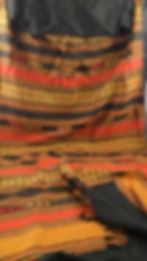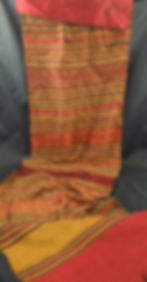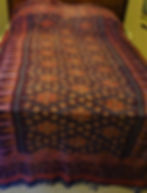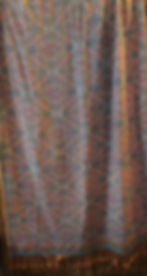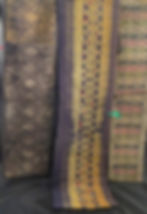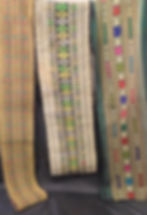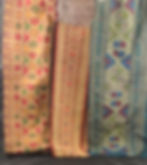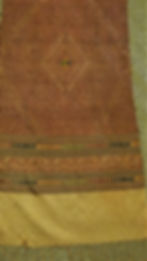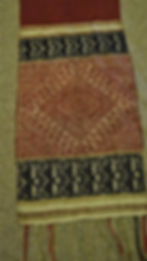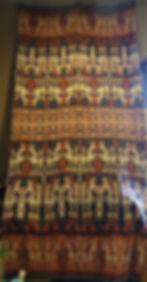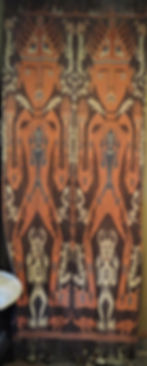tribal textiles from south east asia
Thailand, Laos, Myanmar( Burma), Indonesia
The ancient art of hand-weaving fabric has its roots in the primary obvious purpose to cloth the human body although a need for ornamentation creeps into any clothing tradition. There is a dramatic difference between textiles woven for everyday use & those woven for ceremonial use, the most common occasions for this being: weddings, births, deaths, festivals & spirit worship rites.
HANDWOVEN SILKS & COTTONS OF THAILAND
Thai silk is considered one of the finest fabrics in the world.
Silk fabric is created mainly by Silkworm Moths called Bombyx Mori. These larvae are fed on
Mulberry leaves produce the only natural fiber that is filament fiber. This means that it can be one long continuous fiber if the conditions are products needed for manufacture are endless. The worm secretes a protein-like substance when it enters its pupa stage of life. This protein is called Sericin and it is wrapped around the worm in a cocoon for protection. The most common method of harvesting Silk is to immerse the pupa in warm water and then cold water to soften the gum-like protein. The silk filament can then be refined and processed ready to be wound into skeins and then woven into various silk fabrics. Read more >
We sleep, but the loom of life never stops, and the pattern which was weaving when the sun went down is weaving when it comes up in the morning...Henry Ward Beecher
There are four types of Thai Silk: Brocaded, Dupioni, Mudmee, and Plain Weave.
Featured on this page are Thai silk pieces of the first three types...there are no plain weaves here.
Brocaded Thai silk is a weave that gives the fabric an embossed or raised quality. The fabric is not at all smooth but is raised in a manner that creates a pattern in and of itself. Weaving brocaded silk requires the most expertise and patience of all the various silk weaves. A “sarong bolt”,1 1/2 meters or 4' 11", of quality brocaded Thai silk may take a weaver up to a month to produce.
Dupioni silk intentionally has many fabric knots, bumps, bulges, and “fatties” which give the fabric a great textile character. These fabric inconsistencies are called slubs and are crucial to recognizing authentic Thai silk from its counterfeits.
Classic dupioni silk is woven from silk yarns made from the dupion silk cocoon. A dupion silk cocoon is where two silkworms often jointed together inhabit a single cocoon. Dupion cocoons produce a very rough silk filament and so yarns made with dupion are rough and uneven.
Weaving with this “rough” silk yarn will yield a wonderfully textures fabric we call dupioni.
Thai Mudmee weaving, called Ikat weaving elsewhere, is done on old wooden looms.
All Mudmee, which means tied together, fabric has a design or pattern on it...it is never solid.
Standard woven fabric patterns are created by using different colors on both the horizontal, weft yarns and vertical, warp yarns, threads on a loom. The weaver can then create a desired fabric pattern from the multi-colored threads that her loom has been strung with. Mudmee weaving creates a fabric pattern in a wholly different way. Mudmee weaving creates a pattern with only a single thread, almost always a horizontal weft yarn. Mudmee yarn prior is repeatedly dyed different colors, depending on how many colors are desired for the pattern.
The exact areas of a thread that are to be dyed a certain color, are controlled by a tie-dying method. These ties prevent the dye from affecting the thread underneath them, just like simply tie-dying does. By this method, a skilled mudmee artisan, not always the weaver, can create dyed patterns for a single weft thread. The pattern is then revealed as the vertical and horizontal threads are woven together.
Mudmee threads are not tied and dyed individually. Mudmee patterns are almost always patterns that repeat themselves across a bolt of fabric. Therefore, the mudmee thread is carefully looped across a surface or board that is proportional to the desired width of the fabric. The pattern maker then will tie together a group of threads at precise intervals to create and replicate the desired mudmee pattern.
Mudmee originated Isaan,in Northeast Thailand. Mudmee weaving is the oldest form of pattern weaving in Thailand and dates back approximately 3,000 years when sericulture, silk production, was first introduced to this area. There are hundreds, if not thousands of mudmee fabric designs. In the past, each weaving village in Isaan would have its own patterns unique to a specific village. Mudmee fabric can be either silk or cotton.
Plain weave Thai silk is a smooth, not soft, textured fabric, unlike brocaded silk. Shimmering, an attribute for which Thai silk is famous, is usually easily seen in plain weaves. Undulate the fabric slowly and you’ll see it changing colors. This effect is done by using different colored silk yarns for the vertical, the warp, and horizontal , the weft....from mythailand.blog
vintage hem bands, teen jok
These Brocaded silk pieces are added to the bottom of Phasin Tiin Joks , a long fabric that is often wrapped around the waist like a skirt or a sarong. They are called Teen Jok, the bottom of the skirt.
Embodied in every intricate weave of the phasin tiin jok is the history of the Lanna women, from the matriarchal grip they had on society to their eventual descent into the passivity of patriarchal modernity. Lanna people are the people of Chiang Mai
Every Phasin Tin Jok has its own story. Throughout the changes in Lanna’s history, it has steadfastly remained a creative and exquisite expression of these people’s identity and heritage. Every pattern represents a diversity of motifs behind Lanna culture and the phasin tiin jok is one of the reasons why the ancient northern kingdom is celebrated for its beauty in art and culture.
Designs differ widely in various regions of Thailand as well as the age & status of the weaver.
Life is a Loom, Weaving Illusion...Vachel Lindsay
Vintage Hem Bands & Fabrics
Hinggi: Antique Funeral Shrouds,
of Sumba, Indonesonia
Hinggi is a rectangular cloth, generally, 8 feet in their longest dimension, that were traditionally worn as male-exclusive formal attire at wedding and burial ceremonies and at other feasts, festivals, and ceremonial events or as funeral shrouds. They are usually made in pairs; one cloth is wrapped around the hips, and the other is thrown over the shoulder.
The Hinggis shown here is for wrapping the cherished dead. They look new because they were never used. The pairs of weaving have been sewn together perfectly, you have to look closely to see this union, to create the large rectangle
Hinggi is a subvariant of ikat, a type of textile that is defined not by the method of weaving, but by the tie-dying technique used to color bundles of threads for a textile’s warp, Once the dyed threads are ready, they must be carefully arranged so that when woven they properly align and create the desired patterns. This requires an incredible degree of planning and precision for both the weaving and dying. Traditionally this work was exclusively done by women. As one might imagine, the difficulty of weaving these textiles led to the limited production of Hinggi. Other considerations also limited production. Dyeing was restricted to one window per year by the growth cycle of the indigo plant and weaving could only be done during the dry season. Given all of this, It might take multiple years for a weaver to create even one Hinggi.
People of Sumba maintain animistic ties to the Marapu or ancestral beliefs, still following the traditional ways of caring for the land and maintaining strong social ties. You will see these motifs in the hinggis: interlinking star motif or kandunu mapa kelung denoting social status; lions or mahang motif derived from the image of rampant lions found on Dutch coins, representing power & bravery; deer or ruhu pattern symbolizing high caste; horses that are the Sandalwood Ponies indigenous to the island; shrimp & lobsters symbolizing rebirth—shrimps because they shed and replace their shells, & lobsters because they can regenerate their limbs in a process of renewal; animals of ritual sacrifices, such as cocks or chickens.
Weaving is found only in the far east and far west of the island of Sumba because of an ancient belief that the island is suspended in place by cosmic threads passing through the center of the island. Weaving in the center of the island might weaken the cosmic threads resulting in the island falling to the bottom of the sea.
The weavings in the cosmic web are not self-contained.
Rather, they are part of the design of our collective humanity...Lisa Hunt
Antique Funeral Shrouds
INdonesian Sumba Ikats
Indonesian Sumba Ikats
The Ikat patterns were made by using supplementary warp threads, which float above the red base fabric. Crafting these patterns is a painstaking process; the weaver has to plan every element of the design in advance and insert as many as several hundred heddle sticks into the unwoven threads on the loom, to help her raise just the right warps for each pass of the weft.
These are ceremonial pieces worn over the shoulder.


